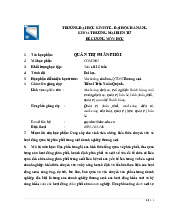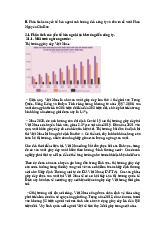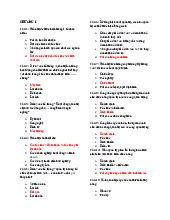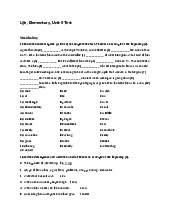















Preview text:
lOMoARcPSD| 49328981 1. Course Title: MANAGEMENT 2. Course Code: MGT1002 Business 3. Program: Administration 4. Credit Number: 3 credits 5. Course Aims:
Managers in any organizations (business, non-business) and in any fields
(human resources, manufacturing, finance, marketing, etc.) have to carry out many
management activities through the process of planning, organizing, leading and
controlling. In this module, learners are provided with a clear understanding of how a
managers execute the management process to efficiently and effectively achieve
organisational goals in a specific environment. 6.
Course Learning Outcomes (CLO)
Upon the completion of the course, student will be able to: No CLO
Course Learning Outcomes . code
Analyse management theories regarding management functions in 1 CLO1 an organisation.
Analyse impacts of organisational environment factors (internal and 2
CLO2 external) on management functions as well as activities of the organisation.
Apply management knowledge and skills learned to make decision 3 CLO3
in practical situations of management functions.
Develop at introductory level fundamental skills for managers 4 CLO4
including communication; team work and decision-making.
Be aware of the importance of ethics, cooperation, activeness, 5 CLO5
integrity in performing management tasks. lOMoARcPSD| 49328981
Matrix showing the alignment of Course Learning Outcomes (CLO) with Program Learning Outcomes (PLO)
7. Students’ Responsibilities
- Students must strictly follow rules, must attend the theoretical lecture, make and
submit assignments as required. 8. Course Materials 8.1 Course book
TL1. Kỷ nguyên mới của quản trị, Richard L Daft, Cengage Learning, NXB Hồng Đức, 2016
TL2. Quản trị học, Lê Thế Giới (chủ biên) NXB Tài chính, 2011
8.2 Reference book(s)
TK1. Fundamentals of Management Ricky W Griffin; 7th Edition, South-Western, Cengage Learning, 2014
TK2. Essentials of Management A Dubrin: 9th Edition, Thomson South-Western, Cengage Learning, 2012
TK3. Documents related to the personal assignments and other assignments during the lecture-time. TK4. Teaching slides 9. Grading Policy: Credit Based System
10.Detailed Course Content CHAPTER 1
OVERVIEW OF MANAGEMENT- MANAGEMENT IN lOMoARcPSD| 49328981 UNSTABLE ENVIRONMENT 1.1
Definition of organization and management . 1.1.1 Definition of Organization
1.1.2 Definition of Management 1.2
Functions of management . 1.2.1 Planning 1.2.2 Organizing 1.2.3 Leading 1.2.4 Controlling 1.3
Efficiency and effectiveness of the organization . 1.4 Management skills . 1.4.1 Conceptual skills 1.4.2 Human skills
1.4.3 Technical skill 1.5
Classification of managers .
1.5.1 Classifying managers by vertical approach
1.5.2 Classifying managers by horizontal approach 1.6
Characteristics of a manager
1.6.1 The initial steps to become a manager 1.6.2 Manager Activities 1.6.3 Manager Roles 1.7
Small Business Management and Nonprofit Organizations 1.8
Modern management competencies Study Material
TL1. Chapter 1, . Kỷ nguyên mới của quản trị, Richard L Daft, Cengage
Learning, Hong Duc Publishing House, 2016
TL2. Chapter 1, Quản trị học, Associate Professor Le The Gioi (Editor) Finance Publishing House, 2011 CHAPTER 2
THE EVOLUTION OF MANAGEMENT THINKING lOMoARcPSD| 49328981 2.1
Management and Organization 2.2 Classical Perspective . 2.2.1 Scientific management 2.2.2 Bureaucracy management 2.2.3 Management principles 2.3
Humanistic Perspectives . 2.3.1 The original initiators
2.3.2 Human Relations Movement
2.3.3 Human Resources Perspective
2.3.4 Behavioral Sciences approach 2.4 Management Science . 2.5 Contemporary trends . 2.5.1 System thinking 2.5.2 Contingency View
2.5.3 Total quality management 2.6
Innovative management thinking in the changing world . 2.6.1 Modern management tools
2.6.2 Technology-oriented workplace management Study Material TL1.
Chapter 2, . Kỷ nguyên mới của quản trị, Richard L Daft, Cengage
Learning, Hong Duc Publishing House, 2016
TL2. Chapter 2, Quản trị học, Associate Professor Le The Gioi (Editor) Finance Publishing House, 2011 CHAPTER 3
ORGANIZATION ENVIRONMENT 3.1.
The External environment
3.1.1 Macro / General environment 3.1.2
Micro/Task environment 3.2. Relationship
between organization and environment 3.2.1 Environment Uncertainty lOMoARcPSD| 49328981
3.2.2 Adapting to the Environment 3.3.
The Internal environment: organizational culture 3.3.1 Symbols 3.3.2 Stories 3.3.3 Heros 3.3.4 Rituals 3.4.
Types of organizational culture 3.4.1 Adaptability Culture 3.4.2 Achievement Culture 3.4.3 Involvement Culture 3.4.4 Consistency Culture 3.5.
Management in the global environment
3.5.1 Globalization and development of global thinking 3.5.2 Multinational companies
3.5.3 Setting up international business activities
3.5.4 International business environment
3.5.5 International trade alliances Study Material TL1.
Chapter 3, . Kỷ nguyên mới của quản trị, Richard L Daft, Cengage
Learning, Hong Duc Publishing House, 2016
TL2. Chapter 3, Quản trị học, Associate Professor Le The Gioi (Editor)
Finance Publishing House, 2011 CHAPTER 4 PLANNING AND STRATEGY 4.1.
Overview of goal setting and planning
4.1.1 Levels of plan and goals
4.1.2 Planning process of the organization 4.2.
Goals setting in organizations 4.2.1 Organizational Mission 4.2.2 Goals and Plans
4.2.3 Align Goals Using a Strategy Map 4.3. Operational planning
4.3.1 Criteria for Effective Goals
4.3.2 Management by Objectives
4.3.3 Single and Standing Plans 4.4.
Benefits and limitations of plan 4.5.
Planning for a turbulent environment lOMoARcPSD| 49328981 4.5.1 Contingency Planning 4.5.2 Building Scenarios 4.5.3 Crisis Planning 4.6.
Innovative approaches to planning
4.6.1 Set Stretch Goals for Excellence
4.6.2 Use Performance Dashboards
4.6.3 Deploy Intelligence Teams 4.7. Thinking strategically 4.8. Strategic Management 4.6.1 Purpose of strategy 4.6.2 Levels of strategy 4.9.
The Strategic management process
4.6.1 Formulation and implementation of strategy 4.6.2 SWOT Analysis 4.10.
Formulating Company-level strategy 4.6.1 Portfolio Strategy 4.6.2 BCG Matrix
4.6.3 Diversification strategy 4.11.
Formulating Business-level strategy
4.6.1 BCG matrix Competitive environment
4.6.2 Porter’s Competitive strategies 4.12.
Formulating Functional-level strategy 4.13.
International Business Strategy 4.6.1 Export strategy 4.6.2 Globalization strategy 4.6.3 Multi-domestic strategy 4.6.4 Transnational strategy 4.14. Strategy Execution Study Material TL1.
Chapter 7 & 8, Kỷ nguyên mới của quản trị, Richard L Daft, Cengage
Learning, Hong Duc Publishing House, 2016 TL2.
Chapter 4, Quản trị học, Associate Professor Le The Gioi (Editor)
Finance Publishing House, 2011 CHAPTER 5 DECISION MAKING
5.1. Types of decisions and problems
5.1.1 Programmed and non programmed decisions lOMoARcPSD| 49328981
5.1.2 Facing uncertainty and ambiguity 5.2.
Models of decision making
5.2.1 Ideal and rational Model 5.2.1 Administrative Model 5.2.3 Political Model 5.3. Decision making steps
5.3.1 Recognition of requirements of decision making
5.3.2 Diagnosis and analysis of causes
5.3.3 Development of alternatives
5.3.4 Selection of the desired alternative
5.3.5 Implementation of the chosen alternative 5.3.6 Evaluation and feedback 5.4. Personl Decision Model 5.5.
Why do managers make bad decisions? 5.6.
Innovative decision making Material TL1.
Chapter 9, . Kỷ nguyên mới của quản trị, Richard L Daft, Cengage
Learning, Hong Duc Publishing House, 2016
TL2. Chapter 5, Quản trị học, Associate Professor Le The Gioi (Editor) Finance Publishing House, 2011 CHAPTER 6 ORGANIZING 6.1.
Organizing the Vertical Structure 6.1.1 Work Specialization 6.1.2 Chain of Command 6.1.3 Span of Management
6.1.4 Centralization and Decentralization 6.2.
Designing elements in the organizational structure
6.2.1 Vertical Functional structure 6.2.2 Divisional Structure 6.2.3 Matrix approach 6.2.4 Team approach
6.2.5 Virtual network approach 6.3.
Organizing for Horizontal Coordination 6.3.1 Coordination Needs
6.3.2 Task Forces, team and project management 6.3.3 Relational Coordination 6.4.
Factors Shaping Structure lOMoARcPSD| 49328981
6.4.1 Structure Follows Strategy
6.4.2 Structure Fits the Technology Study Material
TL1. Chương 10, Richard L Daft, Cengage Learning, Nhà xuất bản Hồng Đức, 2016
Chapter 10, Kỷ nguyên mới của quản trị ,Richard L Daft, Cengage
Learning, Hong Duc Publishing House, 2016
TL2. Chương 6, , PGSTS Lê Thế Giới (chủ biên) Nhà xuất bản Tài chính, 2011
Chapter 6, Quản trị học, Associate Professor Le The Gioi (Editor)
Finance Publishing House, 2011 CHAPTER 7 LEADING 7.1.
The Nature of Leadership 7.2.
Contemporary Leadership 7.2.1 Level 5 Leadership 7.2.2 Servant Leadership
7.2.3 Authentic Leadership leaders 7.2.4 Interactive leaders 7.3.
From management to leadership 7.4. Leadership Traits 7.5. Behavioral approach 7.5.1 Task Versus People 7.5.2 The Leadership Grid 7.6. Contingency Approaches
7.6.1 The Situational Model of Leadership
7.6.2 Fiedler's Contingency theory
7.6.3 Situational Substitutes for Leadership 7.7.
Charismatic and Transformational Leadership 7.7.1 Charismatic Leadership
7.7.2 Transformational leadership and Transactional leadership 7.8. Followership 7.9. Power and influence 7.9.1 Hard Position Power lOMoARcPSD| 49328981 7.9.2 Personal Soft Power 7.9.3 Other Sources of Power
7.9.4 Interpersonal Influence Tactics Study Material
TL1. Chapter 15, Kỷ nguyên mới của quản trị ,Richard L Daft, Cengage
Learning, Hong Duc Publishing House, 2016
TL2. Chapter 9, Quản trị học, Associate Professor Le The Gioi (Editor) Finance Publishing House, 2011 CHAPTER 8 MOTIVATION
8.1. The concept of motivation
8.1.1 Personal needs and motivation
8.1.2 Intrinsic and Extrinsic Rewards 8.2.
Content Perspectives on Motivation 8.2.1 The Hierarchy of Needs 8.2.2 ERG theory
8.2.3 Two-factors approach in motivation 8.2.4 Acquired Needs theory 8.3.
Process Perspectives on Motivation 8.3.1 Goal Setting 8.3.2 Equity Theory 8.3.3 Expectancy Theory 8.4
Reinforcement Perspective on Motivation 8.4.1 Direct Reinforcement 8.4.2 Social learning theory 8.5.
Job design for motivation 8.5.1 Job Enrichment
8.5.2 Job Characteristics Model 8.6.
Innovative ideas in motivation
8.6.1 Building a thriving workforce
8.6.2 Empowering People to Meet Higher Needs
6.8.3 Giving Meaning to Work Through Engagement Study Material lOMoARcPSD| 49328981
TL1. Chapter 16, Kỷ nguyên mới của quản trị ,Richard L Daft, Cengage
Learning, Hong Duc Publishing House, 2016
TL2. Chapter 8, Quản trị học, Associate Professor Le The Gioi (Editor) Finance Publishing House, 2011 CHAPTER 9 CONTROLLING 9.1. Meaning of control 9.2. Feedback control model 9.2.1
Setting up performance standards 9.2.2
Measuring the actual performance 9.2.3
Comparing performance with standards 9.2.4
Carrying out correctives activities 9.2.5 Balanced Scorecard 9.3. Budget Control 9.3.1 Expense Budget 9.3.2 Revenue budget 9.3.3 Cash Budget 9.3.4 Investment Budget 9.3.5 Zero-based Budget 9.4. Financial Control 9.4.1 Financial Statements 9.4.2 Financial analysis 9.4.3 Financial ratios 9.5
Changes in control philosophy 9.5.1
Decentralized approach in control
9.5.2 Open Management 9.6.
Total quality management 9.6.1 TQM Techniques 9.6.2
The factors making success for TQM 9.7.
Trends in quality and finance control 9.7.1
International quality standards system 9.7.2 Corporate Governance Study Material lOMoARcPSD| 49328981
TL1. Chapter 19, Kỷ nguyên mới của quản trị ,Richard L Daft, Cengage
Learning, Hong Duc Publishing House, 2016 TL2.
Chapter 12, Quản trị học, Associate Professor Le The Gioi (Editor)
Finance Publishing House, 2011 lOMoARcPSD| 49328981
11.Matrix showing the alignment of Course Learning Outcomes (CLO) with Course Contents
12.Matrix showing the alignment of Course Learning Outcomes (CLO) with Teaching Learning Methods (TLM) lOMoARcPSD| 49328981 Practice/ lOMoARcPSD| 49328981 Lecture Total Discussion(*) 1 Overview of management 4 2 6 TLM1,TM2,TLM11, TLM15 2 Evolution of TLM1,TM2,TLM11, 1 2 3 management thinking TLM13,TLM12,TLM15, TLM16 3 Organizational TLM1,TLM2,TLM6,TLM11, 4 2 6 environment TLM12,TLM13,TLM15, TLM16 4
Planning and strategy TLM1,TLM2, TLM6,TLM11, 4 2 6 TLM13,TLM15, TLM16 5 Decision making 3 1 4 TLM1,TM2, TLM11,TLM15 6 Organizing 4 2 6 TLM1,TM2, TLM4,TLM15 7 Leading 4 2 6 TLM1,TM2, TLM11,TLM15 8 Motivating 4 1 5 TLM1,TM2, TLM11,TLM15 9 Controlling 2 1 3 TLM1,TM2, TLM11,TLM15 Total 30 15 45
Notes: Number of actual practice/discussion periods is as twice as the designed period number of practical work/discussion
14.Matrix showing the alignment of Course Learning Outcomes (CLO) with Assessment Methods (AM) lOMoARcPSD| 49328981 Method No. Code Assessment methods Group 1 AM1 Attendance Check 1
15. Assessment timelines lOMoARcPSD| 49328981
Approval of Department/Academic Division




